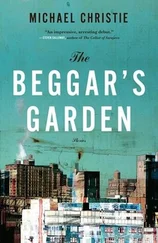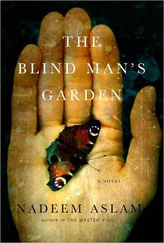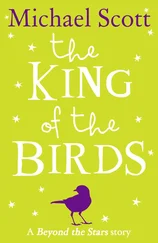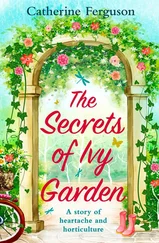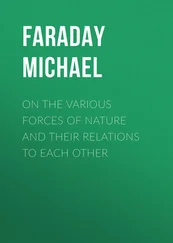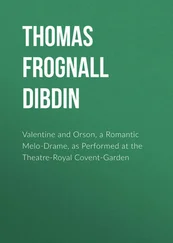The chart opposite lists some of the most useful and attractive flowers for your meadow, but what you can grow successfully obviously depends on the soil. One sure way to find out what might be best for you is to have a good look at the surrounding countryside, including the roadside verges. Flowers that grow well there are likely to do well in your meadow. You can collect the seeds by shaking the ripe seed-heads into paper bags, but never dig up the wild plants. If you have access to the Internet you can call up a website that allows you to see a list of all the plants growing in your area just by inserting the first half of your postcode ( see here). It also tells you whether the plants are garden-worthy and lists the suppliers of native plant seeds. It is very important always to use native seeds; foreign seeds, even if they are of the same species, may be adapted to different conditions and their genes may contaminate and damage our native flora.
Drifts of delicate pink cuckoo flowers adorn many areas of damp grassland in the spring, and they are often accompanied by bright yellow cowslips .
Sow your seeds in the autumn, but do not expect a mass of colour in the first summer – many seeds will not even germinate until the spring, and the young plants need a full season’s growth before they are ready to flower.
Meadows were originally created by grazing and/or cutting, so you need to cut your flower meadow at least once a year. Use a scythe or a strimmer if possible, but if you have to use a mower make sure that the blades are not set too low.
Cut in late summer or autumn for a good display of spring flowers, such as cuckoo flower, cowslip, fritillary, bugle and dandelion.
Cut in spring and autumn for summer colour from the likes of knapweed, lady’s bedstraw, scabious, meadow cranesbill and ox-eye daisy.
Always leave the cut vegetation on the ground for a day or two to allow any seeds to fall, but then make sure you clear it all away because a good flower meadow depends on poor soil fertility.
If you are lucky enough to have a large meadow area, you can mow paths through it more frequently so that you can enjoy the flowers at close quarters.
An area of long grass can look untidy even if it is full of flowers, so it is a good plan to mow the edge to stop the grass from tumbling on to your path or drive. You might like to mow the area nearest to the house as well and allow it to merge gradually into the longer grass, much as a golf course fairway grades into the rough.
If you live in open countryside, you could even construct a ha-ha boundary (a sunken fence or ditch) so that your wild meadow appears to drift off into the surrounding fields.
MEADOW PLANTS
These native plants are suitable for you to plant in your wildlife meadow:
| • Bladder campion |
• Cowslip |
| • Cuckoo flower * |
• Field scabious |
| • Greater knapweed |
• Ox-eye daisy |
| • Meadow cranesbill |
• Ragged robin * |
| • Self heal |
• Yarrow |
Plants marked *will thrive in damp areas.
The meadow cranesbill is one of the most beautiful of our grassland species. It does best on lime-rich soils, where its bright violet-blue flowers can be seen throughout the summer .
Most houses come complete with some sort of boundary feature – a hedge or a wall if you are lucky, but more often a relatively barren wooden fence. Although walls and fences can support a limited range of plant and animal life, a mature hedgerow is a thriving community, teeming with insects and other animals. At the same time it can give you privacy and protect your garden from the wind .
You could consider enriching your garden by replacing your fence with a hedge, but only if the neighbours agree! Alternatively, you could plant a low hedge inside your boundary or instal one as the garden equivalent of a room-divider – separating your vegetables from your flower beds perhaps. Hedges are very cheap to create, although they do need more maintenance than walls and fences.
Michael Chinery
The nests of caterpillars of the small eggar moth were once common on roadside hawthorn hedges, but mechanical trimming in summer has caused the species to become rare. Garden hedges may be its salvation .
Michael Chinery
Although it is very conspicuous when viewed on a bare twig, the 10cm (4in) caterpillar of the privet hawkmoth is surprisingly hard to spot in a privet hedge .
Although exotic species may bear plenty of tasty berries for the birds, they do not support many insects ( see here), so native shrubs are best. Hawthorn is good as it grows quickly, even from cuttings, and it is eaten by more than 150 insect species in Britain alone. Blackthorn, field maple, spindle, dogwood, buckthorn, alder buckthorn and guelder rose are also good. You can encourage honeysuckle, brambles and wild roses to scramble over the hedge. In fact, the more species you can incorporate, the better.
A hedge is both a home and larder for numerous garden animals.
 BirdsSong thrushes, blackbirds, greenfinches, dunnocks and long-tailed tits all nest in garden hedges. The last two are happy to nest among slender twigs, but the others like to build in a stout fork and are most likely to nest in older hedges. Many more birds find food among the branches.
BirdsSong thrushes, blackbirds, greenfinches, dunnocks and long-tailed tits all nest in garden hedges. The last two are happy to nest among slender twigs, but the others like to build in a stout fork and are most likely to nest in older hedges. Many more birds find food among the branches.
 MammalsHedgehogs, shrews, mice and voles all forage in the leaf litter at the base of the hedge. Stoats and weasels – Europe’s smallest carnivores – may also hunt there.
MammalsHedgehogs, shrews, mice and voles all forage in the leaf litter at the base of the hedge. Stoats and weasels – Europe’s smallest carnivores – may also hunt there.
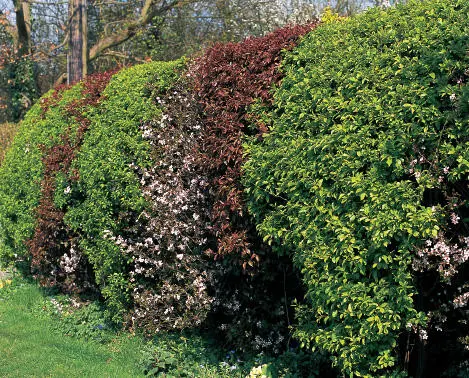
Michael Chinery
Rolando Ugolini
The cultivated Prunus shrubs which make up this superb garden hedge are just as good for nesting birds as the wild shrubs .
 InsectsThese abound in the hedgerow and they play a vital role in feeding the local bird population. However, you will need a keen eye to spot the twig-like caterpillars of the geometrid moths, such as the swallowtailed moth and some of the thorn moths. The hairy and colourful caterpillars of the vapourer, grey dagger and yellowtail moths are much easier to find. Most birds will avoid these hairy caterpillars because the hairs of some species can cause severe irritation. Spiders thrive on the insect life, although we tend not to notice these fascinating small garden creatures until the autumn when their webs are more visible ( see here).
InsectsThese abound in the hedgerow and they play a vital role in feeding the local bird population. However, you will need a keen eye to spot the twig-like caterpillars of the geometrid moths, such as the swallowtailed moth and some of the thorn moths. The hairy and colourful caterpillars of the vapourer, grey dagger and yellowtail moths are much easier to find. Most birds will avoid these hairy caterpillars because the hairs of some species can cause severe irritation. Spiders thrive on the insect life, although we tend not to notice these fascinating small garden creatures until the autumn when their webs are more visible ( see here).
GARDEN PROJECT– PLANTING A HEDGE FOR WILDLIFE
A hedge is best planted in the winter, and all the plants should be pruned to no more than about 30cm (12in) in height after planting them to encourage the growth of interlocking shoots. Don’t be too eager with your secateurs after that. A hedge does need to be trimmed from time to time, but if you want a really good wildlife hedge then you should do this only once every two years.
Читать дальше
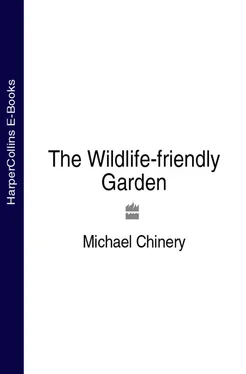
 BirdsSong thrushes, blackbirds, greenfinches, dunnocks and long-tailed tits all nest in garden hedges. The last two are happy to nest among slender twigs, but the others like to build in a stout fork and are most likely to nest in older hedges. Many more birds find food among the branches.
BirdsSong thrushes, blackbirds, greenfinches, dunnocks and long-tailed tits all nest in garden hedges. The last two are happy to nest among slender twigs, but the others like to build in a stout fork and are most likely to nest in older hedges. Many more birds find food among the branches.
